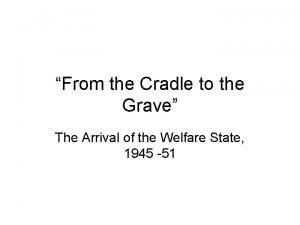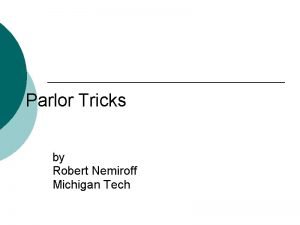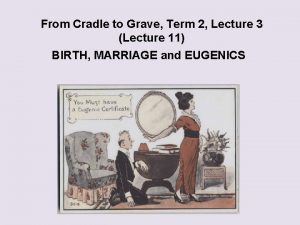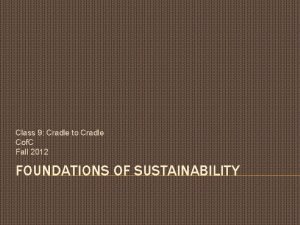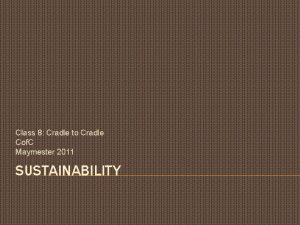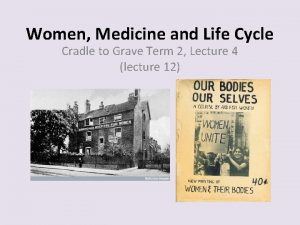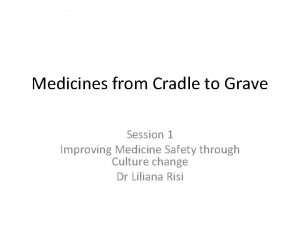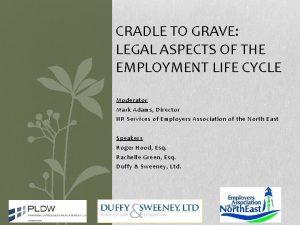From Cradle to Grave Work and Health Term




























- Slides: 28

From Cradle to Grave Work and Health, Term 2, Lecture 7

Lecture Outline and Themes 1. 2. 3. 4. 5. Effect of industrialisation on health (C 19 th) Relationship between working conditions and health (factory system, individual trades) How successful were the measures taken to solve health problems caused by industrialisation? Can work be good for health? Work and life cycle – prime of life/middle working years, but for much of C 19 th also old and young people. Work is one of biggest influences on the health of an individual and family.

Population & Urbanisation 1800 1850 Population of Britain 11 m 21 m London 1 m 2. 4 m Manchester % urban dwellers 25, 000 (1775) 400, 000 c. 50% c. 80% 1851 1901

Crowded and insanitary conditions for the labouring poor resulting from industrialisation

Poverty and squalor - Blue Gate Fields, 1872. Taken from London: A Pilgrimage by Blanchard Jerrold and Gustave Doré.

Contemporary Accounts (1830 s) Frederick Engels on Manchester environment and Charles Turner Thackrah on poor of Leeds ‘Everywhere the heaps of debris, refuse, and offal; standing pools for gutters, and stench which alone would make it impossible for a human being in any degree civilised to live in such a district’. (Engels, 1830 s) ‘I saw, or thought I saw, a degenerate race human beings stunted, enfeebled, and depraved men and women that were not to be aged children that were never to be healthy adults. ’ (Thackrah, 1832)

Contemporary Accounts • Charles Turner Thackrah, The Effects of the Principal Arts, Trades and Professions, and of Civic States and habits of Living, on Health and Longevity (1831). First to write on relationship between work/different trades and health • J. P. Kay, The Moral and Physical Condition of the Working Classes employed in the Cotton Manufacture in Manchester (1832) • P. Gaskell, The Manufacturing Population of England, Its Moral, Social and Physical Condition (1833) • Edwin Chadwick, Report on the Sanitary Condition of the Labouring Population (1842) • Dr Calvery Holland, Diseases of the Lungs from Mechanical Causes and Inquiries into the Condition of the Artisans exposed to the inhalation of dust (1843) (Sheffield physician)

Industrialisation - Optimists • Industrialisation allowed Britain to escape from population pressure on limited resources • ‘First industrial nation’ – prestige of Britain • Belief in continual progress – socially, economically – will raise the standards of living for all • Measurable by rising incomes, falling mortality. Ill effects have been exaggerated • Pessimists rely on impressionistic evidence of ‘horror stories’

Industrialisation – Pessimists (e. g. E. P. Thompson) • Rapid urbanisation and industrialisation caused a drastic deterioration in living and working conditions • Economic growth did not justify this – exploitation of working classes by ruling elite • Children and women in particular exploited by industrialisation, and people continued to work well into old age. Retirement a relatively new concept.

The Factory System: Discipline and Danger (Derek Fraser, Welfare State, pp. 12 -13. ) Discipline: ‘For 12 mortal hours does the leviathan of machinery toil on with vigour undiminished and with pace unslackened and the human machines must keep pace with him. What signify languor, sickness, disease? The pulsations of the physical monster continue and his human agents must drag after him. ’ Danger: ‘Unfenced machinery took its toll of fingers; hair and loose clothes which, often because of fatigue, were allowed to fall into what the novelist Francis Trollope called “the ceaseless whirring of a million hissing wheels, ” and the long hours of standing and bending produced the characteristic weak legs and arched back of the former child operative. ’ Morality: ‘Factories and especially mines were corrupting influences upon young children, who soon adopted the licentious morals of their young adult colleagues. ’

Discourses of youth, morality, poverty, industrialization and race all combine here. . . ‘Thousands of little children, both male and female, but principally female, from seven to fourteen years of age, are daily compelled to labour from six o’clock in the morning to seven in the evening, with only - Britons, blush while you read it! - with only thirty minutes allowed for eating and recreation. Poor infants! Ye are indeed sacrificed at the shrine of avarice, without even the solace of the Negro slave; ye are no more than he is, free agents; ye are compelled to work as long as the necessity of your needy parents may require, or the coldblooded avarice of your worse than barbarian masters may demand! Ye live in the boasted land of freedom, and fell and mourn that ye are slaves, and slaves without the only comfort which the Negro has’. ‘Yorkshire Slavery’, Richard Oastler to Leeds Mercury 16 Oct 1830 (From Fraser, Welfare State, pp. 254 -5)

Saltaire, West Yorkshire Titus Salt’s new industrial community, c. 1850

Robert Owen, New Lanark

Legislation • 1802 Health and Morals of Apprentices Act – maximum 12 hour day for pauper apprentices • 1819 Peel’s Act – Forbad children under 9 from working in cotton mills – children over 9 were limited to a 12 hour day • 1833 Factory Act (textile industry only) – Minimum age of 9 in cotton mills – 9 -13 Maximum 8 hour day – 13 -18 Maximum 12 hour day • 1842 Mines Act – Excluded women and children under 10 • 1844 Factory Act – Allowed children of 8 – but only 6. 5 hours • 1867 Factory Act Extension Act - (premises over 50 people) – Minimum age of 10 – 10 -14 Half day working – 14 -18 and women, maximum 10 hour day

Metal grinders of Sheffield (Thackrah pp. 92 -5. ) Life Expectancy: ‘It appears, that in 1822, out of 2, 500 grinders, there were not 35 who had reached the age of 50, and perhaps not double that number who had reached the age of 45. ’ Industrial Diseases: ‘the symptoms of the grinders’ disease are difficulty of breathing. . . sonorous cough. . . spitting of blood. . . expectoration of mucus, containing often dust, and, in the latter stage, of fetid and purulent matter; muddiness of complexion; anxiety of countenance; pulse quickened. . . sweats and diarrhoea; emaciation; - in a word the signs of slow but certainly fatal consumption. ’ Different conditions for different categories of worker? ‘Remedies recommended by Dr Knight: ‘Dusting the machines. . . great reduction in the time of labour. . . use of wet stones as much as possible. . . large flues to be laid on the floor for ventilation. . . fork-grinding to be confined to criminals. ’

Matchmakers and phossy jaw • ‘Phossy jaw’, phosphorus necrosis of the jaw occupational disease caused by white phosphorus used in matchmaking industry C 19 th. C/e. C 20 th • Symptoms: toothache/swelling of gums followed by abscesses/death of bone/brain damage and death • White phosphorus = active ingredient matches up to 1910. • London matchgirls strike 1888 • William Booth (Salvation Army) opened matchmaking factory in 1891 using red phosphorus. • White phosphorus prohibited internationally 1906 and legislation in individual nations followed.

Phossy jaw

More Legislation 1878 Factory and Workshops Act banned women and children from working with white lead and phosphorous dipping. 1883 Preventing Lead Poisoning Act set standards for ventilation, lavatories, meal rooms, baths, protective clothing and respirators 1896 Dr Arthur Whitelegge appointed Chief Inspector of Factories. Emphasis on industrial disease rather than sanitation 1891 Factory Act transferred sanitary control away from factory inspectors to local authorities. 1895 Factory and Workshop Act required notification of industrial diseases for first time See Antony S. Wohl, Endangered Lives (1984) for more details on public health and occupational health legislation.

State Intervention • Idea from c. 1870 s that active management – including of conditions and health – necessary to manage productive labour (see Steve Sturdy) • Reform delivered unevenly and very localised • Resistance to state interference though gradually implemented reforms • Humanitarian concerns – campaigns • Gender and protective model (motherhood): see Barbara Harrison Limitations of intervention? – Supported capitalists - by protecting children and women - the adult male worker was left unprotected – Patriarchal system - by excluding women from areas of work it supported sexual segregation of the labour market and gender inequalities in wage rates and access to work – Some workers traded off earnings against health or were resistant themselves to employer or state intervention in health at work

Turn of 20 th century: women and work • Women’s work opposed due to race issues – damage of industrial labour/unfitted women for motherhood - reduced physical capacity for childbearing; breastfeeding more impractical; detrimental to moral fibre of society if mothers not at home with young children • Women’s work not necessarily damaging but worked long hours e. g. as chars, factories, shops, restaurants (home workers/sweated labour) • Yet extra money important to families. Textile districts of West Yorkshire infant death rate lower than e. g. South Wales and Durham where women less likely to work • Conflicting evidence : Birmingham 1909 -10, babies better chance of reaching first birthday if mothers worked; in Glasgow same period high IMR related to mothers working up to delivery.

Early 20 th century • Small children also continued to contribute to economy – delivery boys, servants, domestic workers • Half-timers/‘little mothers’/boy labour problem • 1909 Trades Boards Act – minimum wage sweated trades, though condition remained notorious • 1901 Factory and Workshop Act women and children still permitted to work 60 hours a week, up to 12 hours at a stretch. Many factories fell below conditions set for ventilation, drainage, heating, etc • 1840 Factory Inspectors appointed, 1893 first female inspectors – slowly expanding • Workmen’s compensation – response to work-related illhealth, prompted by organised labour (accidents and ill health not responsibility of worker but employer)

1 st World War By end of C 19 th cluster of legislation to project men and women in the workplace, though much ignored or not properly implemented; smaller workshops harder to supervise Impact of 1 st WW – War emergency. Factory Acts relaxed, labour shortage, new machinery meant safety compromised Highlighted women’s health issues, due to drafting in of large numbers of women into workforce Munitions – highlighted specific dangers. Health of Munition Workers’ Committee – concern with hazards, fatigue, etc. Role of welfare supervisors - moral as well as health imperatives Later stages of war recognised good health of workers crucial – welfare provision extended e. g. canteens.

Munitions work

Interwar years Standards still low, worsened in Depression – filthy conditions, health hazards, noise, risk of accidents 1937 Factory Act – raised standards of safety, health and welfare Large, well-organised and successful firms increasingly improved welfare services, including health provisions Industrial medicine emerges as part of industrial welfare – factory potentially a site of health (see Vicky Long). Interest in relationship health and productivity. Those in work liable to poor conditions and health risks but also those out of work – poverty, poor diet and demoralisation (Pilgrim Trust Men Without Work 1938). See also London’s Pulse (MOH reports, Wellcome Library)

Bournville village and factory

2 nd World War Safety, health and welfare at work a priority Ernest Bevin (General Secretary Transport Workers Union) appointed Minister of Labour and National Service 1940 Factories (Medical and Welfare Services) Order July 1940 – extended medical supervision, welfare supervision, nursing and first aid. Workplace becomes place of health promotion – posters, films, leaflets on food safety, hygiene, spitting and TB. Provision of workers canteens extended Research into absenteeism – highlighted strain of war, lowering of physical fitness, stress

Employment, unemployment and health Working class suffered disproportionately from unhealthy working conditions and unemployment Workplace itself increasingly vigilant and also a site of good health practices Intensification of work and new forms of organisation lead to fatigue and stress (replaced risk to physical health/accidents/poor environmental conditions) Relationship between depression, recession and health – anxiety, poor standard of living, risky jobs. Unemployed appear to have worse health, higher risk of suicide and death Strong relationship between mental health and employment – work actually good for health

Modern Records Centre • The Modern Records Centre on campus houses the largest collection of Trade Union material in the UK – occupational health, women and health at work, maternity, material on individual trades etc.
 Cradle to grave cradle to gate
Cradle to grave cradle to gate Sustainability & resource productivity consulting
Sustainability & resource productivity consulting Cradle to cradle boek
Cradle to cradle boek Cradle to grave housing report
Cradle to grave housing report Limburg principles
Limburg principles Cradle to grave
Cradle to grave Cradle to grave
Cradle to grave The cradle of civilization
The cradle of civilization Golden cradle kindergarten
Golden cradle kindergarten Cradle pattern
Cradle pattern Comfort devices bibliography
Comfort devices bibliography Okonkwo's attitude as he prepares to return to the clan is
Okonkwo's attitude as he prepares to return to the clan is Cradle of liberty merit badge college
Cradle of liberty merit badge college Dynamics of machines
Dynamics of machines Newton's cradle
Newton's cradle Leg cradle to lateral lunge
Leg cradle to lateral lunge Cradle of the renaissance
Cradle of the renaissance Newton's cradle
Newton's cradle Newton's cradle tricks
Newton's cradle tricks Jose rizal childhood memories
Jose rizal childhood memories Craddle alignment technique
Craddle alignment technique Pizzle eye
Pizzle eye Mesopotamia the cradle of civilization worksheet answers
Mesopotamia the cradle of civilization worksheet answers Scholarship merit badge
Scholarship merit badge Short term planning and long term planning
Short term planning and long term planning Short term human resource planning
Short term human resource planning Difference between long term and short term liabilities
Difference between long term and short term liabilities Accounting for serial bonds
Accounting for serial bonds Long term goals examples for freshers
Long term goals examples for freshers



